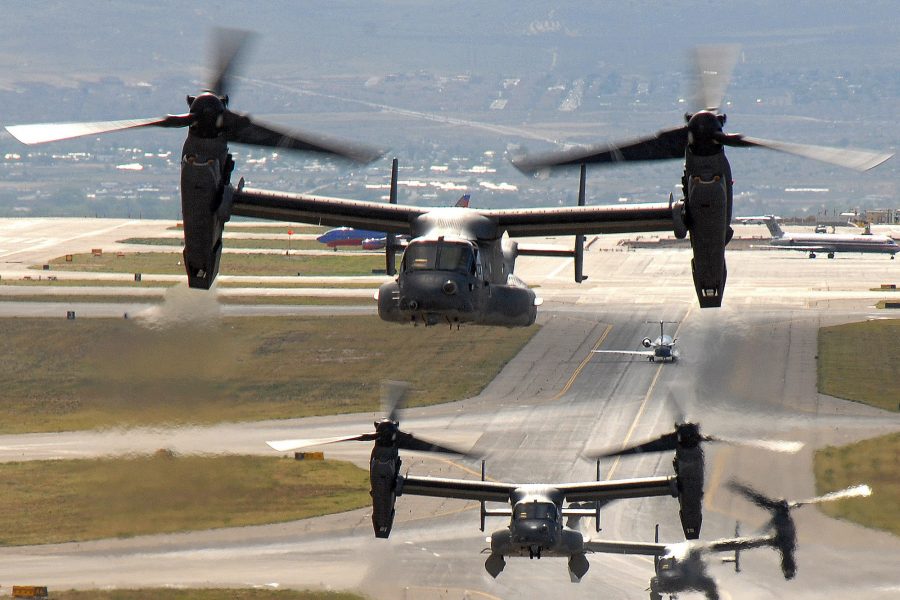The Air Force will consider the Army’s recently-selected Bell V-280 Valor tiltrotor aircraft as a possible solution to its long-range combat rescue helicopter needs—but the service will also look into using CV-22s and other new aircraft, Chief of Staff Gen. Charles Q. Brown Jr. told the House Armed Services Committee on April 27.
Brown, testifying on the fiscal 2024 budget request, was asked if the Air Force, which has purchased all the CV-22 Ospreys it plans to buy, would consider buying more to use for combat rescue in the Indo-Pacific, where long ranges challenge the new HH-60W Jolly Green IIs. The Air Force has cut its planned buy of HH-60Ws from 108 to 85 because they can only meet requirements in the European and Middle East theaters, USAF officials have said.
“I don’t see us actually going to additional CV-22s or opening back [up]” production, Brown said. “Once you shut down the production line, it’s very expensive to start back up. And oh, by the way, it’s technology that’s somewhat dated.”
The prototype joint-service V-22 rolled out in 1985 but the Marine Corps MV-22 did not enter service until 2007, having endured a lengthy and problematic development program. The Air Force declared the CV-22 variant operational in 2009. The Navy declared initial operational capability with its own unique variant of the Osprey, called the CMV-22, in February. The variant has been adapted to meet the Navy’s need for ship-to-shore logistics, replacing the venerable C-2 Greyhound.
Brown said the Air Force would evaluate the V-280, which won the Army’s Future Long-Range Assault Aircraft (FLRAA) competition, and vehicles from “other industry partners…[who are] actually going down this path as well.”
Brown did not specify those other options, but the Sikorsky-Boeing Defiant co-axial helicopter which lost the FLRAA, is available, and leaders such as Air Combat Command chief Gen. Mark Kelly have suggested an outgrowth of the service’s Agility Prime “flying car” technology as a possible fix.
In the interim, Brown suggested the CV-22 could be a solution for long-range combat rescue, as well as a resupply aircraft in the service’s new Agile Combat Employment concept, which will distribute small groups of aircraft and Airmen to remote or austere locations from central “hubs.”
“These are the kinds of things we’re looking at as an Air Force, not only for what the CV-22 is able to do for … hostage rescue but also for personnel recovery and other aspects of logistics in the Indo-Pacific,” Brown said.
Air Combat Command has stressed in recent months that it has no plans to claim Special Operations Command CV-22s to carry out the long-range combat rescue helicopter mission.
Lt. Gen. Richard Moore, deputy chief of staff for plans and programs, told the Senate Armed Services airland panel on April 26 that 85 HH-60Ws “is more than sufficient” to do the combat rescue helicopter mission.
“There’s a big distinction in this portfolio between combat search and rescue and personnel recovery,” he added. “There are literally thousands of platforms in the Department of Defense that can do personnel recovery.”
The HH-60W fleet “is for something very specific. It was purchased for [the] Iraq and Afghanistan [theaters]. It is not particularly helpful in the Chinese AOR” or area of operations, Moore said.
Lt. Gen. James Slife, deputy chief of staff for operations, added to the SASC panel that the Air Force still regards the recovery of downed Airmen a “moral imperative.”
Recalling the effort to save “Bat 21” in Vietnam, Slife said, “the challenge is … no matter how dedicated you are, if you’re not in a platform that’s survivable to the threat environment, you end up losing more people” with an attempted recovery than were downed in the first place.
“We’re actively looking at non-traditional ways in order to fulfill that moral imperative,” Slife added. “… But until we can come to a definitive answer on that. I think the one thing we can say is, helicopters [that fly at 150 knots, refueled by C-130s] is probably not the answer in our most stressing scenarios.”
The 85 HH-60Ws can bridge the gap “until we can develop a more suitable solution for a contested environment,” he said.
Bell Textron won the Army’s $1.3 billion contract for the Valor in December 2022, and the Sikorsky-Boeing team’s subsequent protest of the choice was denied in April. Prototype V-280 aircraft will be fabricated over the next 19 months. Army officials said the Valor was selected as the “best value” proposal across considerations of performance, cost, and schedule.
The FLRAA is potentially worth up to $70 billion, as it will largely replace the Army’s aging fleet of UH-60 Blackhawks.
The Air Force has traditionally met its much smaller need for helicopters by tacking on to Army utility helo programs like the UH-60 and before that, the UH-1. However, the service did select the Boeing MH-139 Gray Wolf, based on the Leonardo AW139, as its VIP/missile field support helicopter.
The Army is slated to get its first Valor prototype in 2025 and achieve initial operational capability circa 2030.

